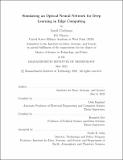Simulating an Optical Neural Network for Deep Learning in Edge Computing
Author(s)
Cochrane, Jared
DownloadThesis PDF (3.878Mb)
Advisor
Englund, Dirk
Oye, Kenneth
Terms of use
Metadata
Show full item recordAbstract
Deep learning has risen to prominence in fields from medicine to autonomous vehicles. This rise has been driven by improvements in parallel computing from graphics processing units (GPUs) as well as large data sets. Applying deep learning to edge computing is challenging because deep neural network (DNN) hardware must not only possess the needed computational power but must also satisfy size, weight, and power (SWaP) constraints for practical deployment. Many DNNs require a GPU or data center to run, both of which are too large to fit onto edge devices. Here, an optical neural network (ONN) accelerator called netcast is simulated on two real-world machine vision applications: MNIST digit classification and scene recognition. The netcast ONN enables large DNNs to run on SWaP-limited edge devices with significantly less energy needed to run inference compared to digital models. Software simulations are used to assess netcast’s performance on MNIST classification and scene recognition
relative to digital networks. Using an accuracy per energy consumption figure of merit (FOM), the simulations indicate that netcast is able to outperform digital electronics on average by over three orders of magnitude. Netcast’s strong performance relative to its digital counterparts indicates that it will enable the novel deployment of large DNNs to edge applications in a way that would be infeasible using current digital electronics. Netcast’s novel applications give rise to a host of policy challenges, one of which focuses on defining and applying acceptable performance metrics to optically enabled deep learning.
Date issued
2022-05Department
Massachusetts Institute of Technology. Institute for Data, Systems, and SocietyPublisher
Massachusetts Institute of Technology